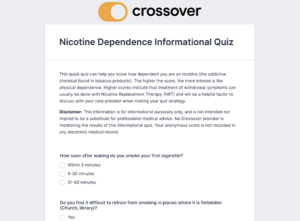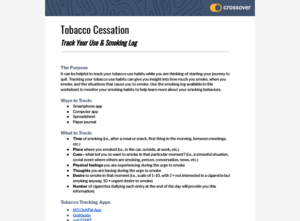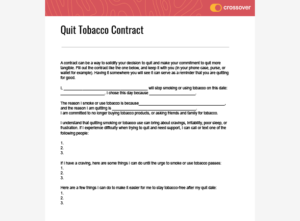
Tobacco Cessation
It’s very challenging to quit tobacco just by thinking about it or using sheer willpower. Tobacco cessation usually takes a tailored plan that targets the reasons why it can become so addictive. If you or someone you know is addicted to tobacco, this self-care guide was created to help you kick the habit, for good.
Learn. Find useful info and videos about quitting tobacco.
Practice. Take advice and tips from Crossover providers.
Let us help. Become tobacco-free with expert guidance.

What You’ll Learn About Tobacco Cessation
- How nicotine affects your body's overall health (not just the lungs)
- Safe nicotine replacement products
- Thinking about quitting? Weigh your pros and cons (calculate your savings!)
- Are you ready to quit? Take our quiz. Sign our contract.
- Setting achievable goals to becoming a non-smoker
- It's not a perfect path...slips happen!
- How your Crossover care team can help
Expert Guidance Along the Way
-
Camilla Lee, NBC-HWCVirtual Health CoachCamilla is a registered dietitian nutritionist and a board-certified health and wellness coach. As a health coach at Crossover, she loves to help people set themselves up for success. This involves creating routines that make healthy choices feel easy and building consistent habits to bring balance and support self-care.
-
Brett McCurdy, RDN NBC-HWCHealth CoachBrett is a Registered Dietitian with a BS in Family and Consumer Sciences—Food and Nutrition. As a Health Coach, he enjoys working with Crossover members to achieve their weight management, exercise, nutrition, and lifestyle goals. Brett has experience working with all age groups. It's never too early or too late to focus on healthy living.
Nicotine is the highly addictive compound found in many tobacco products such as cigarettes, cigars, and chewing tobacco. This chemical compound can have such a negative influence on your mood, behaviors, and health that it ends up motivating you to want it out of your life for good. In this section, you will learn more about the science of why people become dependent on nicotine, and the various forms of Nicotine Replacement Therapy that are available to help you quit.
Nicotine Dependence Quiz
The Science of Reliance
One of the reasons quitting tobacco is so difficult is because nicotine is such an addictive substance. It’s very challenging to quit tobacco just by thinking about it or using sheer willpower. Tobacco cessation usually takes a tailored plan that targets the various aspects of why it can become so addictive. The factors that affect dependence can be:
Physical
When inhaling cigarette smoke or chewing tobacco, the chemicals from nicotine reach the brain within 7-10 seconds. This is typically associated with a rush of relief, or a calming feeling. Typically this calming feeling occurs due to your physical dependence on nicotine, not the nicotine itself. Science has found substances like nicotine often affect the “reward” pathway in your brain. This part of the brain informs you that activities such as eating, sex, or social encounters feel good. As your addiction progresses, the brain is “hijacked” by nicotine, resulting in continued use of tobacco in order to experience pleasure. This reinforcement of the substance may increase your tolerance, forcing you to use more tobacco for the same effect. It also causes cravings where you feel you “need” the substance for the feeling it gives you.
Psychological
Similar to the way nicotine can take over your brain, certain behaviors you engage in reinforce your dependence as well. For example, if you use cigarettes to take a break from work, or escape a stressful situation, over time it can reinforce that nicotine is your coping mechanism—you “need” it in order to manage certain situations.
Environmental
 Humans are social creatures by nature—who and what we are around consistently has an impact on us. This affects your reliance on tobacco as well. Maybe you grew up in a household where your parents smoked, or maybe those around you use tobacco, making it a large part of your social circle. If that’s the case, you’ll need to discuss ways to find social interaction outside of smoking, or learn how to set boundaries with those who may be smoking around you. Not everyone you socialize with will be willing to change their own behavior to help you. But often, you can use your social circle to support your efforts to quit. Your family may be supportive as well, or can help remind you of your goals.
Humans are social creatures by nature—who and what we are around consistently has an impact on us. This affects your reliance on tobacco as well. Maybe you grew up in a household where your parents smoked, or maybe those around you use tobacco, making it a large part of your social circle. If that’s the case, you’ll need to discuss ways to find social interaction outside of smoking, or learn how to set boundaries with those who may be smoking around you. Not everyone you socialize with will be willing to change their own behavior to help you. But often, you can use your social circle to support your efforts to quit. Your family may be supportive as well, or can help remind you of your goals.
When creating your plan to quit, you and your therapist will address all three of the above areas. The best approach will include all three as they apply to your life. If you need inspiration or are meeting barriers, your therapist can help you brainstorm some additional ideas.
Helping You Quit: NRT and Smoking Cessation Medications
When you initially stop smoking, your body misses the nicotine that you have been absorbing. Some people find it helpful to use Nicotine Replacement Therapy (NRT). NRT is when you take nicotine into your body by means other than tobacco, in an effort to quit using tobacco. NRT, especially when used along with other smoking cessation medications, significantly increase your odds of quitting successfully. The counseling and support that are available from your Crossover therapist or health coach are another layer of support that can help you reach your goals.
Learn more about how these products can support you with stopping tobacco below:
Nicotine Patch
How does it work?
- The patch is applied to a clean, dry area of the skin. It delivers small doses of nicotine throughout the day. The nicotine goes into your bloodstream to help replace the amount you were getting from smoking.
How long do I use it?
- You start using the patch on your quit date. Depending on the amount of tobacco you used, patches are used for either 8-10 weeks. The dose of nicotine from the patch slowly decreases as the weeks go by, until you don’t need any at all.
What are the precautions to keep in mind?
- If you have unusual dreams or trouble sleeping, remove the patch before going to bed and put a new one on the next morning.
- Itching, burning, or tingling may occur when the patch is first applied to the skin, but that should go away within 24 hours.
- Avoid leaving the patch on for more than 24 hours—most people take it off when they sleep, and apply a new patch in the morning.
- Wearing the patch should eliminate urges to use tobacco, because it’s depositing nicotine in your system. If your urge to use persists, it may mean that you need a higher dose patch. Talk to your health coach or provider if this is the case. Generally speaking, you should not regularly smoke with a patch in place.
- You may experience headache, nausea, upset stomach, or dizziness. Switching the placement of the patch can reduce some side effects. Refer to the drug facts on the package for more information, or talk to your provider about any concerns.
Nicotine Gum
How does it work?

- Nicotine from the gum passes through the lining of your mouth into your bloodstream to help reduce the physical urge to smoke. As your body adjusts to getting less nicotine, you will gradually reduce the amount you take until the day you do not need any at all.
How long do I use it?
- You start chewing the gum on your quit date. Use the product for a full 12 weeks to increase your chances of success. For maximum effect, chew a fresh piece of gum every 1-2 hours for the first six weeks of your quit (minimum of 9 pieces).
What are the precautions to keep in mind?
- The gum is stickier and harder to chew than ordinary gum so if you have dental work done, sensitive teeth, or other mouth issues, consider other NRT options.
- Do not eat or drink anything for 15 minutes before (or during) chewing.
Nicotine Lozenge
How does it work?
- Nicotine from the lozenge is absorbed through your mouth and passes into your bloodstream. Lozenges come in two strengths—2mg and 4mg. If you smoke within 30 minutes of waking up, or you have a strong addiction to nicotine, use a 4mg dose. If you smoke your first cigarette more than 30 minutes after waking up, use the 2mg strength.
How long do I use it?
- Lozenges are used for a full 12 weeks. During the first six weeks, you’ll use at least nine lozenges per day (every 1-2 hours). When you feel the urge to smoke, place a nicotine lozenge in your mouth and allow it to dissolve slowly, occasionally moving it from side to side.
What are the precautions to keep in mind?
- Do not bite, chew, or swallow the lozenge whole.
- Do not use more than 20 lozenges a day or use more than one lozenge at a time.
Nicotine Nasal Spray
How does it work?
- When spraying into your nose, nicotine passes rapidly into your body through the lining of your nose. Nicotine nasal spray helps relieve unpleasant withdrawal symptoms as well as cravings.
How long do I use it?
- Twelve weeks. Once you’ve stopped smoking cigarettes, use the spray to relieve your cravings for the first eight weeks. Use one spray in each nostril up to twice an hour to relieve cravings (you may find you need less). For the following two weeks, you can start reducing the number of sprays you use. Over the course of the two weeks after that, reduce the number of sprays down to zero.Nasal spray should not be used continuously for longer than 12 weeks.
What are the precautions to keep in mind?
- During the first two days of treatment, many people experience sneezing, runny nose, watering eyes, and cough. If you continue to use the nasal spray, the severity of these effects and how often they occur will reduce.
- Other side effects can include increased heart rate, nasal discomfort, and upset stomach.
Nicotine Inhaler
How does it work?
- The inhaler helps to support quitting by providing a hand-to-mouth ritual that is similar to smoking, which some people find helpful.The inhaler uses a cartridge that delivers a lower dose of nicotine than from a cigarette.
How long do I use it?
- The recommended duration of initial treatment is three months, after the initial period, you can slowly wean from using the inhaler over the course of another six to twelve weeks. During the first 3–6 weeks of treatment, at least six cartridges a day (and up to 16 cartridges a day) is recommended.
What are the precautions to keep in mind?
- The most common side effect with a nicotine inhaler is irritation of the mouth and throat when puffing the device. Cough, hiccups, runny nose, headache, and upset stomach are other common side effects with this method of NRT.
- Safe use of an inhaler for longer than six months has not been established.
It is recommended that you do not use tobacco while using any of the above nicotine replacements. In addition, it’s recommended that you only use one nicotine replacement at a time (don’t chew gum and wear a patch, for example). Using tobacco with a therapy or doubling up on your nicotine therapies can cause you to run the risk of experiencing a nicotine overdose. Signs and symptoms of a nicotine overdose may include: dizziness, upset stomach, bad headaches, blurred vision, and weakness or fainting.
Smoking Cessation Medications
Smoking cessation medications can be prescribed by your Crossover provider. The two most commonly prescribed options are Zyban and Chantix. These medications work very well when combined with NRT.
Bupropion (Zyban) is a prescription pill that is usually taken for 7–12 weeks. It can help reduce cravings as well as an overall urge to smoke without putting nicotine in your system. It may cause side effects from dry mouth to difficulty sleeping. Many people that have used it report that cigarettes do not taste as good after starting this medication.
Varenicline (Chantix) is a prescription medication that is specifically made for quitting smoking. It does not contain nicotine, and helps reduce cravings and withdrawal symptoms. It’s best to start it one week before your quit date, and is usually taken for 12 weeks. Vivid dreams and nausea can occur as side effects; take the medication after eating and with a full glass of water to reduce nausea. If you notice any changes in your mood while taking it, you should talk to your Crossover provider right away.
If you’re thinking about quitting tobacco, then this is the section for you. In the content below, you’ll learn about the benefits of quitting tobacco and the tools that will help you discover when to do it successfully.  You’ll explore where and why you want to use tobacco and you’ll be prompted to think about how to handle negative thoughts that may come up for you either when you think about quitting, or when you think about past efforts to quit (and why those haven’t worked).
You’ll explore where and why you want to use tobacco and you’ll be prompted to think about how to handle negative thoughts that may come up for you either when you think about quitting, or when you think about past efforts to quit (and why those haven’t worked).
Quitting is a Journey
Benefits of Quitting
Benefits of Quitting Tobacco: Health
There are numerous health benefits of quitting tobacco, ranging from having a healthier mouth and skin to reducing your risk of heart disease and cancer. Quitting tobacco use can improve your overall health and quality of life. The sooner you quit, the more health benefits you may see, including being healthy enough to live a longer life!
Below are some of the many health benefits of quitting tobacco use:
- Improved day and night vision
- Healthier teeth and gums
- Better skin and reduced risk of premature aging and wrinkling
- Lowers blood pressure (within 20 minutes!)
- Lowers cholesterol
- Lowers risk of heart disease and heart attack (within 24 hours!)
- Lowers risk of diabetes and helps better manager blood sugar levels if you have diabetes
- Lowers risk of getting cancer
- Lowers risk of erectile dysfunction
- Increases chances of a healthy pregnancy
- Increases ability to breathe better
- Lowers risk of developing COPD
- If not already developed, reduces risk of lung damage and emphysema
- Increases ability of body to heal wounds
- Fosters a stronger immune system
- Helps keep bones and muscles strong
Benefits of Quitting Tobacco: Financial
Tobacco use is an expensive habit. The average cost of a pack of cigarettes in the United States is nearly $7 (some cost over $10!). Depending on how much tobacco you use, quitting may help you realize you are saving a lot of money. The money you aren’t spending on tobacco can be used for all kinds of things—you can save, spend, donate, etc. The options are endless!
How Much Will You Save? Calculator
Benefits of Quitting Tobacco: Social and Mental Health
Not only are you helping your own physical health when you quit using tobacco products, you are also helping the health of those around you, such as family members, friends, and colleagues. You may find that when you stop using tobacco products, others may become more open to spending more time with you, too.
Below are some personal, social, and mental health benefits to quitting tobacco:
- Your sense of smell and taste improve, making food taste better
- You may notice an improvement in your sleep
- You may have more energy and stamina to do daily activities that used to make you tire easily or leave you short of breath
- You may have more time to do other things you enjoy since you won’t be taking smoking or tobacco use breaks
- You may experience more invitations and social interactions as people won’t have to accommodate your tobacco use
- You may feel less isolated
- You may find other ways to relieve stress that are longer lasting and more effective than tobacco use
- You will smell better to yourself and others
- Your family may not be as embarrassed to have others visit your home due to smoke smell
How Ready are You?
How ready are you to make a serious attempt to quit using tobacco? Use this quick, one question screener to determine your level of readiness to quit and learn strategies that can help you move closer to quitting for good.
Consider the following question:
“What are your thoughts and feelings about quitting smoking?”
Now, select the answer that aligns best with how you feel:
- I currently use tobacco and am not ready to quit right now.
- I like to smoke, but I know I need to quit.
- I am ready to quit and am planning to do so within the next month.
“I quit smoking and have been tobacco-free for over six months, but still think about it from time to time.”
 If your response was #1 (I currently use tobacco and am not ready to quit right now.) we’re glad you’re here, learning about what might feel right for you in the future. Perhaps right now you are able to minimize all of the harmful effects of smoking or even rationalize that there are “good” reasons to continue smoking. To help you move forward, reflect on the answer to this question: “If you had the ability to help other people stop smoking, would you use that power?” (see: The Science of Reliance in first section—Tobacco and Nicotine Explained)
If your response was #1 (I currently use tobacco and am not ready to quit right now.) we’re glad you’re here, learning about what might feel right for you in the future. Perhaps right now you are able to minimize all of the harmful effects of smoking or even rationalize that there are “good” reasons to continue smoking. To help you move forward, reflect on the answer to this question: “If you had the ability to help other people stop smoking, would you use that power?” (see: The Science of Reliance in first section—Tobacco and Nicotine Explained)
If your answer was #2 (I like to smoke, but I know I need to quit.), then you may be caught between your desire to quit smoking and a simultaneous desire to keep smoking. Information and facts about smoking have slowly started mixing with the emotional and social forces that come with quitting, but the idea that it could be too difficult or that you’re not quite ready is keeping you stuck. To help you move forward, reflect on this question: “How will your life (or the lives of those closest to you) be improved after quitting?” Begin to visualize the tremendous sense of accomplishment and freedom you will have with overcoming one of the toughest addictions in the world. [Link: Your Reasons for Quitting]
If you most aligned with #3 (I am ready to quit and plan on doing so within the next month.), you’ve reached a point in your mind where you’ve decided it is time to quit smoking—congratulations! As you begin to prepare, the most important thing to know is that you don’t have to do it alone. Help from a Crossover provider can be found not only in the form of Nicotine Replacement Therapy (NRT), but from one-on-one time with a health coach or therapist who can connect with you to discuss handling moments of stress, cravings, or other barriers that could pose a challenge. To help you quit successfully, one question to ask yourself is, “What other support is available to help me quit using tobacco?”
Finally, if #4 (I have quit smoking for over 6 months now but still think about it from time to time.) is your answer, we want to acknowledge that we know it has taken a lot of dedication and commitment to get to this point. It’s likely that you’ve already experienced the benefits and freedom that comes with being an ex-smoker. You may find yourself thinking about smoking from time to time since the risk of a lapse or a ‘slip’ is still relevant. However, you are dedicated to staying smoke-free and may have even found yourself motivated to start improving other aspects of your wellness. Connecting with your Crossover health coach can help you stay tobacco-free and work toward developing the next phase of your best self.
Advantages and Disadvantages of Quitting
Let’s explore some of the advantages to making a change. What are some of the benefits you hope that quitting tobacco might bring?
- I am hopeful that when I quit smoking it will improve my health risks.
- Not using tobacco will bring me more energy.
- I can develop more constructive ways to manage my stress.
- Making good choices for my body shows that I care about my health and wellbeing.
- I can engage in many activities with other people that support my health.
- I can embrace intimacy and build healthy relationships. I can better enjoy the activities I like to do outside of work.
- My home, breath, and clothes will smell better.
- My sense of smell will come back.
- My loved ones will not be exposed to my tobacco use.
- My food will taste better.
- My blood pressure will come down.
- My lung function will improve.
- Exercising will be easier for me.
- My risk of cancer will go down.
- I will save money.
“How will those who are close to you benefit if you quit?”
What are some possible disadvantages you may encounter (or concerns you have) while on your quit journey?
- I’m concerned that I’ll have to fight cravings and temptations and feel deprived.
- I’m worried I won’t be able to enjoy social events with my friends.
- I’m afraid I’ll have to say “no” (or risk hurting others’ feelings) if my friends ask me to participate in activities that conflict with my goal.
- I’m worried that the withdrawal from nicotine will make me feel bad, irritable, and depressed.
- I’m concerned that when things get stressful, there’s a risk that I won’t be able to stick to quitting.
- I’m worried that I will gain weight if I stop using tobacco.
Are there other disadvantages you may encounter while working to become a non-smoker?
 Making the necessary changes to quit tobacco isn’t always simple. Even though the change will be a positive one for you in the long-run (in so many ways!), getting through the process of quitting the habit does come with short-term drawbacks and downsides. The benefits do outweigh the negative, if you are willing to work through the process. Talk openly and honestly with your Crossover health coach so you can create a plan for how to handle the challenges you may encounter as you work through the process of quitting for good. You can do this and we can help.
Making the necessary changes to quit tobacco isn’t always simple. Even though the change will be a positive one for you in the long-run (in so many ways!), getting through the process of quitting the habit does come with short-term drawbacks and downsides. The benefits do outweigh the negative, if you are willing to work through the process. Talk openly and honestly with your Crossover health coach so you can create a plan for how to handle the challenges you may encounter as you work through the process of quitting for good. You can do this and we can help.
Crossover’s Track Your Use and Smoking Log
Download “Track Your Use and Smoking Log”
Track Your Use
When trying to change any habit, the first step is to raise your awareness by tracking your behavior. When you start really paying attention and tracking when, where, and why you are engaging in the behavior you want to quit, you learn valuable information that will help you change it. By taking yourself off of autopilot and getting curious about your triggers and habits, you can learn what environments, emotions, or situations are driving you to engage in the behavior that you are trying to change. What you learn will come in handy when you create a plan to quit. Try using this Crossover Health Smoking Log, create your own, or experiment with a tracking app.
Addressing Negative Thoughts
Negative thoughts can present a big challenge to changing habits. It’s important to identify your negative thoughts related to smoking and use strategies to help you address them so your efforts to quit don’t get off track.
 For example, have you ever thought, “I’ll never be able to quit” or “I feel like a failure and that’s why I can’t stop using tobacco”? These are some examples of negative thoughts. Keep in mind that negative thoughts can be sneaky, sometimes they are so automatic you don’t even notice them. Try and tune into your thoughts from time to time and start identifying (without judgment) your negative thoughts or beliefs. Write them down.
For example, have you ever thought, “I’ll never be able to quit” or “I feel like a failure and that’s why I can’t stop using tobacco”? These are some examples of negative thoughts. Keep in mind that negative thoughts can be sneaky, sometimes they are so automatic you don’t even notice them. Try and tune into your thoughts from time to time and start identifying (without judgment) your negative thoughts or beliefs. Write them down.
Once you’ve identified a negative thought, ask yourself a few follow up questions:
- Is the negative thought 100% true?
- Do you 100% believe the negative thought?
- Is this the only way to look at the situation?
If you answer no to any of these, try reframing the thought in a more helpful way. So, rather than “I’ll never be able to quit smoking” try “Quitting is difficult but I’m putting my all into quitting and this time I’m getting help.”
You can also ask yourself whether you would say that thought to a friend in a similar circumstance. If the answer is no, what would you say to a friend who was struggling with quitting? Try saying that to yourself when the negative thoughts come up.
If you’d like more guided help with addressing negative thoughts or beliefs, reach out to a Crossover mental health therapist or health coach.
If you have decided that it is time to quit tobacco for good and are ready to get started, you’re in the right place. In this section, you will find resources to help you fully prepare to quit. You’ll explore topics such as learning the value of a Wellness Vision, identifying your reasons for quitting, and how to spot the moments that lead to smoking. You’ll also find information about cravings, how to reward yourself, and finding the quitting approach that works best for you. When preparing to quit, the most important thing to keep in mind is that you don’t have to do it on your own. Your Primary Care provider, Health Coach, and Mental Health specialist are all here to help make this attempt your last.
Steps to Quitting
There are six steps to quitting tobacco.
- Choose your quit date and mark your calendar. If you have already chosen your quit date, make sure you tell the people in your life including friends, family, and colleagues.
- Calculate your savings. Tobacco is costly—take a moment to calculate how much you spend on tobacco on a monthly or yearly basis.
- Think about your reasons for quitting. Knowing why it’s important—to YOU—to quit will keep you motivated as you face challenges on your quit journey. Keep Your Reasons for Quitting close to you as you go through the process.
- Know your cues. Planning ahead to avoid and manage the things that prompt you to smoke will set you up for success. These cues may be driven from feelings of withdrawal, emotions, daily patterns, or social interactions.
- Fight your cravings. Cravings are inevitable, but making a plan to deal with them will help. The most important thing to remember is that cravings will pass.
- Set yourself up for success. Know what you will need to have in place to successfully quit. Talk to your doctor about the possible benefits of medications that can be taken in combination with regular sessions with a Health Coach or Mental Health specialist.
Get Clear on What You Want
Smoke-Free Wellness Vision
 A Wellness Vision is a description of how you see yourself in your ideal state of health. Having clear goals are correlated with happiness and life satisfaction, and a vision of your best self serves as a beacon to make sure you are staying on the right track. Crossover Health Coaches specialize in creating the vision of your best self both while you use tobacco and after you quit. Asking yourself the questions below will help get you started with envisioning yourself as an ex-tobacco user:
A Wellness Vision is a description of how you see yourself in your ideal state of health. Having clear goals are correlated with happiness and life satisfaction, and a vision of your best self serves as a beacon to make sure you are staying on the right track. Crossover Health Coaches specialize in creating the vision of your best self both while you use tobacco and after you quit. Asking yourself the questions below will help get you started with envisioning yourself as an ex-tobacco user:
- Who will be there to support you while you work to become tobacco-free?
- What obstacles do you think will be most difficult for you to overcome when quitting?
- How can you handle the times when your desire to use tobacco will be at its strongest (such as when you get upset, angry, or stressed)?
- What is the main motivation behind your decision to quit?
- Once you commit to stop using tobacco, what will be the first step you take?
Your Reasons for Quitting
Why do you want to quit? Whether you have one reason or many, they can be a positive force—even stronger than any desire you have to keep using tobacco. The sample list below, as well as the section “Benefits of Quitting” can both help you build your own case for why quitting is important. Write your own reasons down and keep them accessible. Review the list often, especially on the days leading up to your quit date, or as you’re going through the process of quitting.
- I want to live a longer and healthier life
- I want to save money
- I was advised to quit by my doctor
- I want to be in control of my life
- I’m thinking about getting pregnant
- I have a baby on the way or currently have children and want to set a good example for them
- My family/loved ones/partner want me to quit
- For my pets
- It’s difficult to find places to smoke
- I want to look or smell better
- I want to feel better
Make Your Plans
What are the circumstances, times of day, moods, environments, or people that might drive you to reach for tobacco? These are your “smoking cues” or “tobacco cues” and they are different for everyone. Identifying what they are and learning how to manage them is a key step in the process. Cues can be categorized into four main types:
Emotional
Smoking might be something that elevates a good mood or relieves a bad one. Consider this list of emotions and ask yourself if you’ve ever found yourself smoking due to any of these.
- Stress
- Anxiety
- Excitement
- Boredom
- Sadness
- Irritation
- Happiness
- Loneliness
- Satisfaction
Pattern
A pattern cue is an activity or behavior that you connect with smoking or tobacco use. These are often done automatically, often without even thinking about it. Common pattern cues associated with tobacco include:
- Finishing a meal
- Drinking coffee
- Drinking alcohol
- Talking on the phone
- Watching TV
- Having a break from work
- Driving in the car
- Playing certain sports or activities (golf, fishing, camping).
Social
A social cue would be an occasion that would put you around other people who smoke or use tobacco. The pressure from others (either perceived or real) can pose a threat to your quit attempt. Examples of social cues include:
- With others at a bar
- At a party or social event
- An event such as a concert
- Being around friends who smoke
- Seeing someone else smoke or use tobacco products
- Smoke breaks at work
Withdrawal
If you have been smoking or using tobacco for a while, your body has become accustomed to receiving nicotine doses regularly. Once you quit, you will experience withdrawal cravings for nicotine which serve as a “cue” for wanting to use tobacco. These may include:
- Craving the taste of a cigarette or tobacco
- Smelling cigarette smoke
- Handling cigarettes, lighters, matches or other tobacco-related items
- Needing to do something with your hands or mouth
- A feeling of restlessness
Recognize Your Smoking Stressors
Working to become smoke-free will mean changing what you are used to. Whenever routines are changed, it is natural for stress (even a little bit) to come with it. Stress is how the brain and body respond to a demand. Though it is usually discussed as something we want to avoid, stress is not always a bad thing. The right amount allows you to accomplish tasks throughout the day while providing motivation, inspiration, and creativity for growth and change. The cause of stress (a stressor) generally can result from major or minor life events and can be social, psychological, or physical.
 Common physical and social stressors that can lead to tobacco use may include:
Common physical and social stressors that can lead to tobacco use may include:
- Relationships with friends and family
- Relationships with your boss or co-workers
- Too many time commitments
- Expectations from others/pressure from other smokers to smoke
- Adjusting to new environments
- Financial strain
- Political or world conflicts
- Extreme weather
- Traffic
- Lack of sleep
- Withdrawal from nicotine
- Health problems
- Food insecurity
- Transportation/car troubles
Psychological stressors that can lead to tobacco use may include:
- Boredom
- Frustration
- Indecision
- Worries about the future
- Dwelling on the past
- Anger
- Isolation from friends and family
- Low confidence or self-esteem
- Loss/grief
The process of quitting smoking can be mentally exhausting—it can become one of your stressors. Minimize the chances of lapsing by having techniques to help relax you when stress enters your life. Learn more about Responding to Stressors as you work through the process of quitting.
Stop Smoking Contract | Deciding On an Approach
One of the first steps in quitting tobacco is deciding on how you want to approach it.. You can choose to quit all at once or to gradually reduce your use, which we call “stepping down.”
If you want to quit all at once, set a quit date. This not only gives you adequate time to plan ahead, it serves as a motivator to help you commit to quitting, especially when it is shared with those who support your efforts.
When choosing a quit date, keep these tips in mind:
- Give yourself enough time to prepare, but plan to quit within the next 30 days.
- Choose a date that does not conflict with another potentially stressful event, such as work projects, travel, or visiting family.
- Consider a date that lines up with an event that has special meaning to you. The birthday of a grandchild or child, an anniversary, or day that honors a loved one can serve as a powerful motivator.
- Share your quit date with those who support you, and make it known that you’re quitting for good. Circle the date on your home calendar, or set it as an “all-day-event” in your digital calendar.
A contract can be a way to solidify your decision to quit and make your commitment to quit more tangible. Fill out the contract like the one below, and keep it with you (in your phone case, purse, or wallet for example). Having it somewhere you will see it can serve as a reminder that you are quitting for good.
Stepping Down
Tobacco cessation using the “stepping down” method:
As you have read, heard, and possibly experienced, stopping your use of tobacco can be very difficult. Sometimes it takes several attempts before quitting for good. It can require dedication, and working one-on-one with someone like a health coach can help you determine the best way to quit.
The “stepping down” method is gradual, and often avoids large withdrawal symptoms. It mimics what occurs with Nicotine Replacement Therapy (there is often a similar method of lowering the amount of nicotine in the blood stream until you get to zero).
How does this method work?
There is still a quit date, but it is farther out. Between now and then there are scheduled drop downs in use that you will adhere to. For example, if you smoke 10 cigarettes a day, next week you will smoke 8, then 6, and so on until you reach zero. In the last two weeks, you will commit to not buying any additional tobacco products and will focus on using other techniques discussed on this page (such as cleaning your home, car, or sharing your quit status with others). Social support can be important during this process as stepping down can be challenging. Writing your goals on a calendar can be a helpful visual cue. During this process you can examine what is working, what is difficult, and work on troubleshooting when issues arise. You can also schedule visits with your Crossover health coach to check in, stay accountable, and get support.
Determining if this method is right for you.
The truth is you know yourself best—you will know what will work best for your life. Typically those who are successful using this method respond well to schedules and plans. If you’re avoiding quitting tobacco because you’re worried about withdrawal symptoms or having to stop all at once, easing into a tobacco-free life through stepping down could be a good option for you.
Initiate a Tobacco Quit Attempt
After deciding on an approach to quitting, it is time to start preparing for your quit date. Making a personalized plan to quit using tobacco can help you stay on track.
Review Your Cues
Think about your reasons for quitting tobacco—these reasons can serve as your motivation.
Prepare Your Home, Office, Car, and Personal Spaces
 Cleaning your home, office, car, and other personal spaces can help rid them of any smoke or tobacco smell, as well as ashes or dust from smoking. Even if you are planning on using the stepping down approach, add these things into your timeline as you work to eventually become tobacco-free. For example, “This week I want to stop smoking in my car, so I will get my car detailed and only smoke outside.”
Cleaning your home, office, car, and other personal spaces can help rid them of any smoke or tobacco smell, as well as ashes or dust from smoking. Even if you are planning on using the stepping down approach, add these things into your timeline as you work to eventually become tobacco-free. For example, “This week I want to stop smoking in my car, so I will get my car detailed and only smoke outside.”
Possible things to do:
- Get rid of any tobacco products
- Throw out ashtrays and lighters
- Clean surfaces and surrounding spaces
- Wash your laundry to rid clothes of the smell of smoke
- Vacuum, sweep, and dust
- Steam clean carpets, curtains, decorative pillows, etc.
- Open windows to air out rooms and space
Clean Your Teeth
Getting your teeth cleaned can help remove nicotine stains, make you feel refreshed, and start your smoke quit attempt with a clean slate for your mouth.
Utilize Your Support System
Utilizing your support system can help you achieve your goals. Tell at least two people you know about your quit plan. Create your Stop Smoking Contract if you haven’t made one already.
Prepare Substitutes
Think about what you will do instead of smoking or using tobacco. How will you keep your hands busy?
Anticipate Withdrawal Symptoms
What if you end up feeling irritable, anxious, restless, or if you have a headache or problems sleeping? What can you do to prepare for these?
Avoid Your Cues
Try to stay away from situations and places that will have smoking or that will make you want to smoke.
Practice Saying: “No, Thank You”
People who have been around you when you are smoking may feel comfortable offering you a cigarette or other tobacco product. You may need to tell or remind them that you are working on quitting smoking.
Reflect on Past Quit Attempts
What worked for you in the past? What did not work for you in the past? How can you take those learning experiences into this quit attempt?
Plan For Barriers
Manage Cravings
Cravings are normal when quitting tobacco. They can cause you to experience changes in your mood, increase in your heart rate and blood pressure, and make you question your strength and ability to quit tobacco. It is important to keep in mind that cravings are the worst during the first five minutes. Check-in with yourself after that amount of time and you may be surprised to find that your craving is not as strong. It is also important to revisit your list of cues for tobacco use and aim to avoid these situations as best as you can to help reduce your cravings.
If a craving does strike during your quit attempt, you can:
- Take 10 deep breaths
- Step outside for five minutes
- Drink some water
- Chew a piece of gum
- Walk for 15 minutes
- Work on a crossword puzzle
- Listen to a smoking cessation guided meditation
- Watch a funny video
- Take a relaxing shower or bath
- Call a friend or family member for support
- Call a support line for tobacco cessation
- Reach out to your Health Coach
Plan Your Rewards
Using tobacco actually causes our brain to feel rewarded. The nicotine in cigarettes and other tobacco products can increase the release of dopamine (the “feel good” chemical) into our brains. So when quitting tobacco, it will be important to reward yourself with non-tobacco-related items in order to:
- To help retrain your brain to experience a reward that is not associated with tobacco.
- To allow yourself to celebrate your successes with quitting tobacco.
Daily reward examples:
- 30 minutes alone to read
- 60 minutes to work on a hobby or interest
- A long walk on the beach or a hike
- An evening bath
- Sign up for a new fitness class
- Play a video game
- Watch a TV show
- Enjoy the sense of accomplishment
- Enjoy knowing you could be setting an example for others to follow
Larger reward examples:
- Book a massage
- Taking a day off
- Go to the movies
- Dine at your favorite restaurant
- Sign up for a class that you’ve been interested in, like cooking or art
- Treat yourself to an item you’ve been wanting that supports your efforts (like new walking shoes or a bath bomb)
Think of what daily or monthly rewards can help keep you on your quit path, and make note of them here. Having something to look forward to can help keep you going in the right direction.
Congratulations on quitting tobacco! Take a moment to let this huge accomplishment sink in. You’ve done something amazing for your health, your life, and the life of those around you. You should be very proud of your hard work!
Now, it’s time to prepare for your tobacco-free future. In this section, you’ll learn how to maintain your new, smoke-free life by preparing for slips (which are normal), learning the value of repeated quit attempts, and finding ways to respond to stressors (which can be a big reason for slips). You’ll leave this section armed with tips and tricks to stay tobacco-free.
Slips Happen
Slips are when you might smoke a cigarette or use a tobacco product even after a time period when you didn’t use any at all.
Understanding Slips
- Slips are normal and happen to many people.
- Slips often happen within the first few months of quitting tobacco. They do not mean you are a smoker or a tobacco user again. One slip does not equal failure.
- Slips do not hurt your progress towards quitting tobacco. The way you react to slips is what’s most important. You can learn new ways to react to slips that will help you get you back on track.
Tips for Slips
- Remind yourself of the effort and time that you weren’t smoking or using tobacco—not as a punishment, but as an acknowledgement of what you’ve done and can do again. Give yourself credit for all of the times you avoided smoking and overcame your urges to use tobacco. Consider what helped you stay tobacco-free.
- Reflect on the slip—what led to the slip, what you were feeling or thinking, what you learned, and what you could do differently next time.
- Know your cues for tobacco. When you know your cues, you can make a plan to avoid these high-risk situations. Revisit: Know Your Cues.
- Check your thoughts. Reframe negative thoughts with more truthful or helpful versions. Revisit: Addressing Negative Thoughts.
- Quit again right away. Use the resources that help you best.
- Reach out for support. It may help to talk to a friend, family member, or professional. Don’t be afraid to tell them you need their support.
- Don’t give up!
Feel like you’re struggling with slips? Reach out to your Crossover provider or health coach for help!
Repeat Quit Attempts
Repeated quit attempts are normal. Although having to start over can feel difficult or even overwhelming, know that each time you try to quit, you’re coming to the process with more and more knowledge. It will get better each time until that final attempt where you succeed for good. Here are some tips to consider:
- Consider what worked in previous quit attempts. What do you want to try again this time?
- Revisit your motivation and pros and cons for change. What would help you overcome the barriers to quitting you listed?
- Acknowledge any negative thoughts or feelings you may be having around quitting. Try challenging these thoughts by asking yourself, “How can I think of this in a more positive light?”
- Reexamine your triggers. This is where tracking your tobacco use helps!
- Recommit. Set a new quit date and re-sign your quit contract.
- Prepare yourself: Get rid of your remaining tobacco products, clean the spaces where you usually smoke. Purchase your Nicotine Replacements (NRT) or fill your medication prescription, if using those methods. Talk to those who will need to support you, let them know how they can help.
- Think about what knocked you off track. Plan for future barriers now. What will you do if those barriers arise again?
- Let us help. You don’t have to do it alone—your Crossover care team is here to support you whether you’re quitting all at once or using a stepping down method.
Responding To Stressors
Stress, fatigue, and social discomfort are just a few feelings that can lead to smoking or using tobacco as you seek satisfaction, relaxation, and a calm “reward.” Add in the physical effects nicotine produces, and it’s no surprise why quitting tobacco is so difficult. To be successful with maintaining your quit, physical activity and mindfulness techniques can replace the behavior of smoking, buying you time to allow the urge to pass.
Try some of these techniques next time you’re stressed and the urge to smoke hits:
- Listen to music you love
- Keep your hands occupied—knit, color, play a game, or play with a fidget spinner
- Chew gum
- Write a to-do list or journal
- Call or talk to a friend
- Meditate or visualize. Think about a place that is restful and peaceful. Imagine what you see as you picture this place, what you hear, how you feel, and what smells you notice in the scene. Really immerse yourself!
- Breathe. Close your eyes to tune out any external distractions and bring your attention to your breaths. Begin breathing slowly through your nose and pausing when you’ve taken a full, deep breath. When you’re ready, breathe out through your mouth, pursing your lips as you do. Try this for a few cycles. When your mind wanders, come back to focusing on your breath.
- Get active. This doesn’t need to be in the form of the gym or a full workout—going for a brisk walk, gardening, or doing household chores will work, too. The most important part is engaging in physical movement. It can distract you from the urge to use tobacco at least until the craving passes.
Try one or all of the above techniques to find what works best for you. If you’re feeling stuck on how to respond to stress without tobacco, reach out to a Crossover health coach or mental health provider.
Let us help. We’ve provided a lot of information here to get you started, but you don’t have to do it alone. Your Crossover care team is here to support you whether you’re quitting all at once or using a stepping down method.
Your doctor, health coach, and mental health specialist will help to make this attempt your last.
Talk to your doctor about the possible benefits of medications that can be taken in combination with regular sessions with a Health Coach or Mental Health specialist.
Start a conversation with us today.




